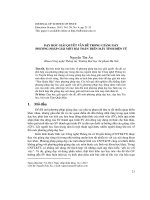Publishing workshop (phuong pháp để đăng một bài báo khoa học)
Bạn đang xem bản rút gọn của tài liệu. Xem và tải ngay bản đầy đủ của tài liệu tại đây (2.21 MB, 48 trang )
Publishing Workshop
“How to publish your research in a top journal”
Dr. Elaine van Ommen Kloeke
Elsevier
Agronomy & Remote Sensing
1
2
What will we cover in this workshop?
•
Understanding scholarly publishing
•
How to get published:
•
•
•
•
3
Preparing
Structuring & writing
Using Proper Scientific Language
Publishing ethics
Understanding Scholarly
Publishing
4
Let’s Start at the Beginning
Journal publishing has thrived for over 340 years but the
fundamental role of Publishers remains unchanged
Registration
Timestamp
Certification
Peer review – validity & integrity
Dissemination
Medium to share findings
First scientific journals
published in 1665
Preservation
Preserve and archive records of science
5
Elzevirianas circa 1629
The Publishing Cycle
30-60%
by >
Solicit rejected
& manage
7,000 editors
submissions
10 million
articles
Archive
&
in archive
promote
use
Manage
peer
500,000+
review
reviewers
>480 million
Publishby& >30
downloads
disseminate
million
researchers
in >180 countries!
Nearly
½ million
Edit
&
articles
accepted
prepare
9.8 million articles
Production
available
6
Peer Review
Helps to determine the quality,
validity, significance and originality
of research
Helps to improve the
quality of papers
Publishers stand outside the
academic process and are not prone
to prejudice or favour
Publishers facilitate the review
process by investing in online review
systems and providing tools to help
Editors and Reviewers
7
rejection
Without it there is no
control in scientific
communication
OUT
rejection
Journal Editors evaluate
and reject certain articles
prior to external peer
review
Submission
Editor
(preliminary Assessment)
Reviewer 1
Reviewer 2
Editor: Decision
accepted
Print Proof
In Press
Branding, logos,
page numbers
Published
8
minor/major revisions required
A well understood
concept
Initial
changes
Principles of Peer Review
Typesetting,
copy editing
The Publishing Industry Over Time…
1665
1580
1880
1989
2000
1998-1999
9
Today
Global Expansion of Research
Compound Annual Growth Rate In Articles
2006-10
40%
35%
Malaysia
30%
25%
Iran
Romania
Saudi Arabia
20%
Pakistan
15%
Egypt
Thailand
India
Brazil
Turkey Taiwan
Republic of Korea
France Germany
United Kingdom
10%
5%
0%
-5%
10
China
United States
Japan
0
100
200
300
Articles 2010 (Thousands)
400
500
Publishing Innovations
Flow
Article
Transfer
Service
Interactive Plots
and Figures
Author
Experience
11
Article of the
Future
Google Maps
Your Paper,
Your Way
Get social!
• New ways to communicate
– Make sure the world knows you and your work
• New communities
– Connect and collaborate
12
‘How To Get Published’
Preparing Your Manuscript
13
Are You Ready To Publish?
14
Are you ready to publish? Guiding questions
• Have you done something new and interesting?
•
Have you provided solutions to any difficult problems?
•
Have you checked the latest results in the field?
•
Have you verified the findings?
•
Did you perform the appropriate controls?
•
Do your results fit - is the story complete?
15
Choosing the right journal
Find the journal that best suits your work:
Look at the Aims & Scope of a journal
Physiological and Molecular
Plant Pathology
Physiological and Molecular Plant
Pathology provides an International forum for
original research papers, reviews, and
commentaries on all aspects of the molecular
biology, biochemistry, physiology,ultrastru
cture, genetics and evolution of plantmicrobe interactions.
Papers on all kinds of infective pathogen,
including viruses, prokaryotes, fungi, and
nematodes, as well as mutualistic organisms
such as Rhizobiumand mycorrhyzal fungi, are
acceptable as long as they have a bearing on
the interaction between microbe and plant.
…
Read The ‘Guide for Authors’
• Find it on the journal homepage of the publisher, e.g. Elsevier.com
• Keep to the Guide for Authors in your manuscript
• Editors do not like wasting time on poorly prepared manuscripts
17
‘How To Get Published’
structuring & writing and your article
18
General structure of a research article
Title Abstract
Keywords
Introduction
Methods Results
AND Discussion
19
Conclusion
Acknowledgements
References
Supporting Materials
Titles
Fewest possible
words
Adequately
describes
content
Identifies main
issue
Effective manuscript titles
20
Does not use
rarely-used
abbreviations
Abstract
< 200 – 300 words
This is the advertisement of your article.
Make it interesting and understandable
Make it accurate and specific
A clear abstract will strongly influence
whether or not your work is considered
Keep it as brief as possible
21
Keywords
22
Highlights
Used by indexing and
abstracting services
Advertise your work
Are the labels of the
manuscript
3-5 bullet points
Use only established
abbreviations e.g. DNA
Key conclusions
Do not repeat words in
the title
Use full sentences
Introduction
Provide a brief context to the readers
Address the problem
Identify the solutions & limitations
What is hoped to be achieved
Consistent with the nature of the journal
23
Methods
Describe how the problem was studied
Include detailed information
Do not describe previously published procedures
Identify the equipment and describe materials used
Other researchers should be able to
reproduce your work using the
method description
24
Results
Be clear & easy to understand
Highlight the main findings
Feature unexpected findings
Provide proper statistical analysis
Include clear illustrations & figures
25









